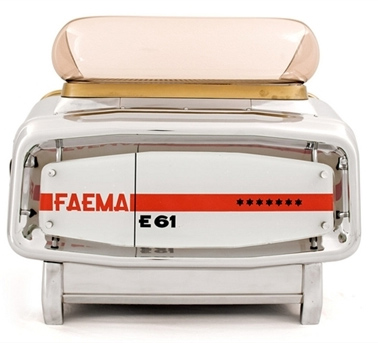Espresso's history : over a hundred yeras of technological development !

For many people, and certainly for all Italians, the word coffee is almost synonymous with the word espresso. But to get the espresso perfect, it took almost 100 years of experimentation and evolution.
Of course, when we talk about evolution in espresso, we mainly look at the birth and improvement of the relevant machines. There are many things around the espresso universe that have evolved over the past 100 years, from blending and roasting techniques to the overall espresso culture as expressed through advertising or even the decoration of cafes. As much as these issues are extremely interesting, this article will mainly follow the technological evolution of espresso machines.
The birth of espresso can be traced in the late 19th century in Italy. Coffee has conquered the entire European continent, and of course Italy was no exception. However, with extraction methods of the time, it was not uncommon for coffee lovers to wait up to five minutes to enjoy their beverage. The first steps towards a faster extraction are made in 1884 by Angelo Moriondo and they are presented at the Torino International Exhibition: Moriondo designs a coffee machine that uses steam - which, in fact, was the great technological achievement of the time - and drastically reduces brewing time. With the current standards, the coffee produced would not be called espresso, since the steam pressure did not exceed 1.5 bars - but the seed for the espresso had fallen.
 A few years later, Luigi Bezzera presents a clearly improved version of Moriondo's machine: he introduces several innovations such as the portafilter, many extraction nozzles, he stabilizes the water temperature to almost 90 ° C. However, Bezzera's engine needed other improvements, since although it could produce a cup of coffee in seconds, it faced difficulties in stabilizing pressure and temperature, so coffee did not always have the same flavor and not even the same size.
A few years later, Luigi Bezzera presents a clearly improved version of Moriondo's machine: he introduces several innovations such as the portafilter, many extraction nozzles, he stabilizes the water temperature to almost 90 ° C. However, Bezzera's engine needed other improvements, since although it could produce a cup of coffee in seconds, it faced difficulties in stabilizing pressure and temperature, so coffee did not always have the same flavor and not even the same size.
This improvement, the taste’s stabilization, came a little later from Desiderio Pavoni. Pavoni bought Bezzera's patent, improved its design even more, and so in 1906, at the Milan International Fair, the two partners served for the first time an "espresso". The name was an inspiration of Pavoni's moment, who seemed to have had talent in marketing: in a few years, Italy was overwhelmed by "Ideale", the espresso machines built by Pavoni, and gradually more and more started to build machines to produce "espresso coffee".
The first espresso machines present considerable problems: they are bulky, expensive, they produce steam pressure up to just 2 bar (now that the standard pressure for making espresso is 9 bar) and most of all due to their construction they often leave a burnt aftertaste in coffee. Nevertheless, the popularity of espresso is growing, thanks to the Art Deco aesthetic campaigns designed by Pier Teresio Arduino, a businessman who in turn has also improved his espresso machine by bringing it closer to its present form.
 To reach today's espresso, we will have to wait until the end of the 1940s when Achille Gaggia introduces machine innovations that will allow the barista to have better control of the brewing, stabilize the espresso size, and bring pressure at the current level of 8-10 bars. In addition to increasing the popularity of the machines, the innovations have led to a feature that is now regarded as an integral part of espresso: its cream. Initially, the suspicious Italians considered the cream to be bad and removed it from their coffee until Gaggia decided to promote the coffee produced by his machines as "Caffe Crema", which slowly made the Italian coffee lovers embrace the new feature of their coffee.
To reach today's espresso, we will have to wait until the end of the 1940s when Achille Gaggia introduces machine innovations that will allow the barista to have better control of the brewing, stabilize the espresso size, and bring pressure at the current level of 8-10 bars. In addition to increasing the popularity of the machines, the innovations have led to a feature that is now regarded as an integral part of espresso: its cream. Initially, the suspicious Italians considered the cream to be bad and removed it from their coffee until Gaggia decided to promote the coffee produced by his machines as "Caffe Crema", which slowly made the Italian coffee lovers embrace the new feature of their coffee.
Gaggia continued to drive developments for the coming years, introducing the legendary Faema E61 espresso machine, which was more compact in size, in 1961, stabilizing the variables (temperature, pressure) even more and being even easier to handle. The dozens of improvements made to the espresso machines from the 60's to the present, are based on the methods used at that time - besides, there is now the established definition of espresso, controlled by the Italian Institute of the same name.
Of course, the enjoyment of espresso is not just technology. The Italians themselves say that for a good espresso, the "four M" must work perfectly: Macchina, the Espresso machine, Macinazione, the right grinding of the coffee beans, Miscela, the blend used, and Mano , the hand of the barista, the human factor. The next time you enjoy an espresso cup, just think that behind these delightful sips is a whole century of exciting technological development!








